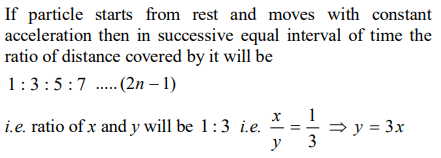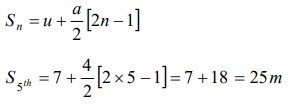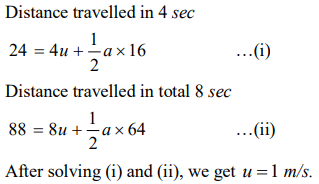1. The acceleration of a moving body can be found from
a) Area under velocity-time graph
b) Area under distance-time graph
c) Slope of the velocity-time graph
d) Slope of distance-time graph
Explanation:

2. The initial velocity of a particle is u (at t = 0) and the acceleration f is given by at . Which of
the following relation is valid
a) \[v=u+at^{2}\]
b) \[v=u+a\frac{t^{2}}{2}\]
c) \[v=u+at\]
d) \[v=u\]
Explanation:

3. The initial velocity of the particle is 10 m / sec and its retardation is \[2m\diagup sec^{2}\] . The distance moved by
the particle in 5th second of its motion is
a) 1 m
b) 19 m
c) 50 m
d) 75 m
Explanation:

4. A motor car moving with a uniform speed of 20 m / sec comes to stop on the application of brakes after travelling a distance of 10 m. Its acceleration is
a) \[20m\diagup sec^{2}\]
b) \[-20m\diagup sec^{2}\]
c) \[-40m\diagup sec^{2}\]
d) \[+2m\diagup sec^{2}\]
Explanation:

5. The velocity of a body moving with a uniform acceleration of \[2m\diagup sec^{2}\] is 10 m / sec . Its velocity after an interval of 4 sec is
a) \[12 m\diagup sec\]
b) \[14 m\diagup sec\]
c) \[16 m\diagup sec\]
d) \[18 m\diagup sec\]
Explanation: v = u + at = 10 + 2 * 4 = 18 m /sec
6. A particle starting from rest travels a distance x in first 2 seconds and a distance y in next two seconds, then
a) \[Y=X\]
b) \[Y=2X\]
c) \[Y=3X\]
d) \[Y=4X\]
Explanation:

7. The initial velocity of a body moving along a straight line is \[7m\diagup s \] . It has a uniform acceleration of \[4m\diagup s^{2}\]. The distance covered by
the body in the 5th second of its motion is
a) 25m
b) 35m
c) 50m
d) 85m
Explanation:

8. The velocity of a body depends on time according to the equation \[V=20+0.1t^{2}\] . The body is undergoing
a) Uniform acceleration
b) Uniform retardation
c) Non-uniform acceleration
d) Zero acceleration
Explanation:

9. Which of the following four statements is false
a) A body can have zero velocity and still be accelerated
b) A body can have a constant velocity and still have a varying speed
c) A body can have a constant speed and still have a varying velocity
d) The direction of the velocity of a body can change when its acceleration is constant
Explanation: Constant velocity means constant speed as well as same direction throughout.
10. A particle moving with a uniform acceleration
travels 24 m and 64 m in the first two consecutive
intervals of 4 sec each. Its initial velocity is
a) 1 m/sec
b) 10 m / sec
c) 5 m/sec
d) 2 m/sec
Explanation:
